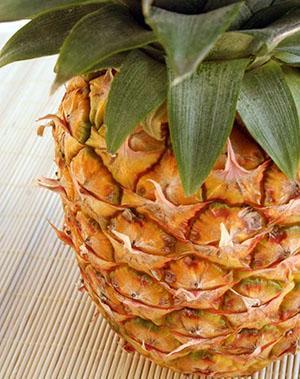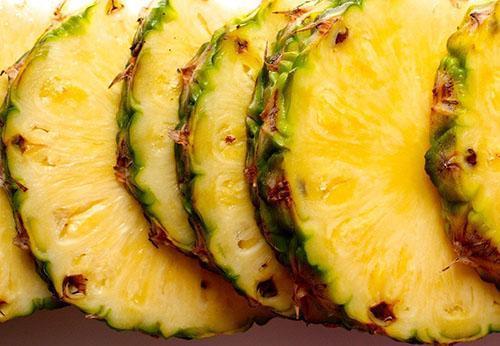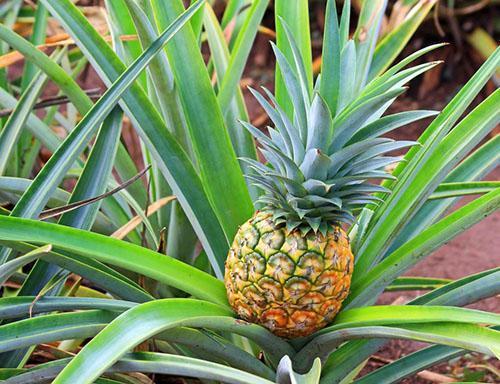How to choose a ripe and sweet pineapple to the table
 It can be difficult for modern children to believe that their parents and grandparents met with the taste of tropical fruits in adulthood, and a hundred years ago, unknown to most of the country's population, pineapples were considered a sign of luxury and excess.
It can be difficult for modern children to believe that their parents and grandparents met with the taste of tropical fruits in adulthood, and a hundred years ago, unknown to most of the country's population, pineapples were considered a sign of luxury and excess.
Today, all kinds of fruits from tropical countries and the most remote corners of the world can be found in almost any store. How to choose a pineapple so as not to be disappointed in the taste of the pulp hidden under the dense skin? Are there any tricks and tricks that allow you to select from the mass of outwardly similar fruits one that does not turn out to be immature or, on the contrary, overripe?
What does a pineapple look like, worth a purchase?

In fact, pineapple, which looks like a single fruit, is an infructation, consisting of many berries arranged in a spiral, which have grown together at the stage of ovary. The fact that in the past they were "independent" is reminiscent only of the characteristic surface of the peel, on which traces of bracts and borders of individual fruits are noticeable.
Inside, the fact that the sweet and sour pulp appeared in the place of the inflorescence is reminiscent of a hard core, that is, a stem that has sprouted through all the fruit. And at the top of a pineapple, such a stem forms a green rosette.
Everyone who has tried pineapple, which has recently grown on a plantation and has not spent long days and weeks on the road, know the exact answer to the question: "Which pineapples are better?" Fruit on the table should be as fresh and ripe as possible. But what if the nearest plantation is many thousands of kilometers away, and pineapples are sold in a shop around the corner, second only to Fedor Konyukhov in travel experience?
Is it possible and how to ripen pineapple?
 Since the consumer cannot change the speed of delivery of fruits from the place of growth to the store, he will have to arm himself with some knowledge when choosing a pineapple. They will help determine the degree of ripeness of the pulp hidden under the skin and the quality of the fruit.
Since the consumer cannot change the speed of delivery of fruits from the place of growth to the store, he will have to arm himself with some knowledge when choosing a pineapple. They will help determine the degree of ripeness of the pulp hidden under the skin and the quality of the fruit.
Unlike bananas, which are harvested on plantations almost green, and then, upon arrival at their destination, are treated with a special gas that causes emergency ripening of fruits, they try to cut the pineapples when they are ripe. The fact is that in bananas and other fruits that can ripen after harvest, the formation of sugar occurs due to accumulated starchy substances. Pineapples do not have them, and it makes no sense to expect that the green sour fruit after a while will become sweeter. Therefore, the frequently asked question: “How to ripen a pineapple bought in a store?” Has to be answered in the negative.
If the pineapple is not sweet, neither turning the fruit upside down, as is sometimes advised, nor keeping it warm or cold will help to change its taste.
 You can store pineapple in the refrigerator for 3–6 days, and the temperature in this case should not be lower than 6–8 ° C, otherwise the pulp will become watery. It is absolutely impossible to leave the fruit in the warmth, since fermentation processes begin quickly under the peel, and the activity of harmful microorganisms in such conditions is sharply activated.
You can store pineapple in the refrigerator for 3–6 days, and the temperature in this case should not be lower than 6–8 ° C, otherwise the pulp will become watery. It is absolutely impossible to leave the fruit in the warmth, since fermentation processes begin quickly under the peel, and the activity of harmful microorganisms in such conditions is sharply activated.
The pineapple left for ripening will not become juicier and sweeter, but only ferment or begin to rot.
How to choose the best quality pineapple?
 In order not to look for ways to sweeten the unripe fruit, you need to do your best in the store and find a ripe sweet pineapple. Before choosing a pineapple, it is useful to look around the showcase and highlight the fruits:
In order not to look for ways to sweeten the unripe fruit, you need to do your best in the store and find a ripe sweet pineapple. Before choosing a pineapple, it is useful to look around the showcase and highlight the fruits:
- with the greenest leafy crown;
- with an even, not pimply "body";
- with a predominance of golden yellow tones in color.
Coming closer to ripe fruits, you can feel the characteristic aroma without signs of acid or a hint of fermentation. The ripe fruits are dense, firm, but not soft to the touch. The skin of the pineapple looks almost even, not lumpy.
Although almost all fruits are roughly ripened when picked on plantations, both green and overripe fruits hit the shelves.
Unripe pineapples can be identified:
- on more convex fragments on the surface of the peel;
- by herbal rather than fruity aroma;
- for a firm, not elastic fruit.
 Pineapple growers claim that fruits that are completely green in color can be sweet, but choosing a pineapple with at least a slight presence of a yellow tint in the color, the buyer is less likely to be disappointed. It's green apples can ripen on the counter and acquire a different taste after storage.
Pineapple growers claim that fruits that are completely green in color can be sweet, but choosing a pineapple with at least a slight presence of a yellow tint in the color, the buyer is less likely to be disappointed. It's green apples can ripen on the counter and acquire a different taste after storage.
 Overripe pineapples give out a soft bottom, sour or yeast notes, a color change from yellow to bronze. As soon as the pineapple accumulates as much sugar as possible, the fruit becomes vulnerable to rot. Since pineapples are treated with fungicides and other substances that prevent spoilage before leaving the plantations, moldy spots or serious softening on the bark may not be found. But inside the overripe, damaged or frostbitten during the transportation of the fruit, destructive processes are already underway.
Overripe pineapples give out a soft bottom, sour or yeast notes, a color change from yellow to bronze. As soon as the pineapple accumulates as much sugar as possible, the fruit becomes vulnerable to rot. Since pineapples are treated with fungicides and other substances that prevent spoilage before leaving the plantations, moldy spots or serious softening on the bark may not be found. But inside the overripe, damaged or frostbitten during the transportation of the fruit, destructive processes are already underway.
Any darkening on the bark, sap drips, soft spots or cracks are warning signs that should serve as a reason to abandon the purchase.
Pineapple ripening begins from its bottom. It is in this part that the fruit is always sweeter, hence the color of the ripening fruit begins to change. In most varieties, a sign of ripeness can be considered bright golden-yellow shades on the peel, at least present on its fragments around the base of the fruit. The higher the yellow color spreads, the more even the sweetness of the pineapple will be.
Is it possible to determine ripeness by the rosette of leaves on a pineapple?
 Speaking about how to choose a pineapple, many mention the possibility of pulling a leaf out of the sultan at the top of the fruit. If the leaf is easy to feed and peels off even with a little effort, the pineapple is considered ripe. Unfortunately, this opinion is wrong. And pulling out the leaves at the counter will only lead to trouble, and not to the purchase of the desired delicacy.
Speaking about how to choose a pineapple, many mention the possibility of pulling a leaf out of the sultan at the top of the fruit. If the leaf is easy to feed and peels off even with a little effort, the pineapple is considered ripe. Unfortunately, this opinion is wrong. And pulling out the leaves at the counter will only lead to trouble, and not to the purchase of the desired delicacy.
Pineapple leaves processed with preservatives dry out naturally during the journey and storage, but do not change color.
Therefore, it is easy to spoil the product, but this will not give any useful information about the pineapple. But the change in the color of the foliage from green to brown or the complete drying of the tuft eloquently indicates an impermissibly long finding of the fruit on the counter or a violation of the rules for its storage.
Which pineapples are better with a lush sultan or a modest rosette of leaves? As a rule, it is recommended to buy pineapples with a rosette at least 10 cm high, but no more than two lengths of the fruit itself. After all, by paying for a large, magnificent sultan, the buyer gets more expensive pulp.
 Sometimes pineapple leaflets are used to decorate the table at special events or dinner parties. In this case, you can preserve the freshness of the foliage for several days if the outlet is carefully unscrewed from the fruit, cleaned of traces of pulp and wrapped in a bag and put in the refrigerator.
Sometimes pineapple leaflets are used to decorate the table at special events or dinner parties. In this case, you can preserve the freshness of the foliage for several days if the outlet is carefully unscrewed from the fruit, cleaned of traces of pulp and wrapped in a bag and put in the refrigerator.
Before buying, it is worth examining not only the fruit itself and its crest, but the place where the stem is cut.If it's uneven, overly elongated, or moldy, choose a more dignified pineapple.